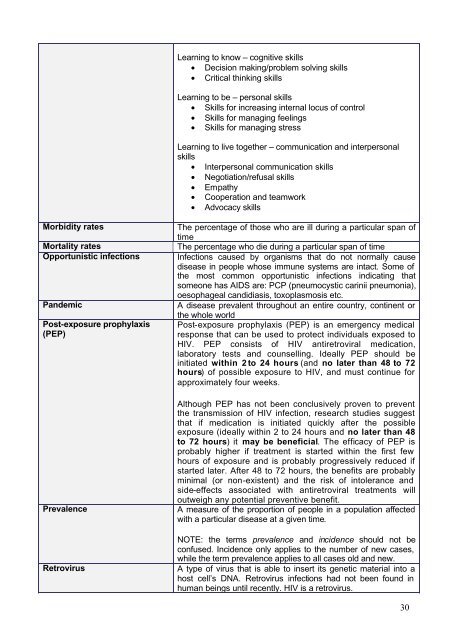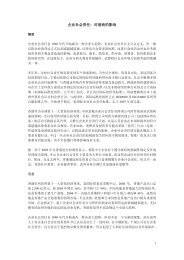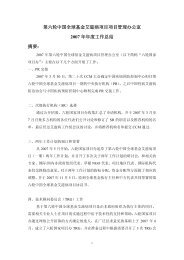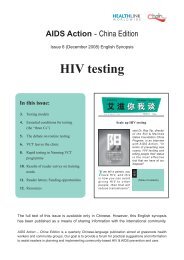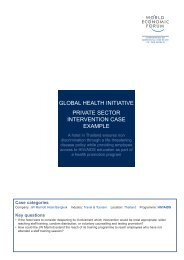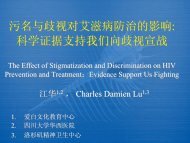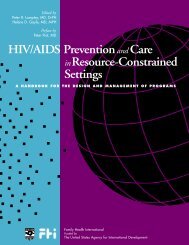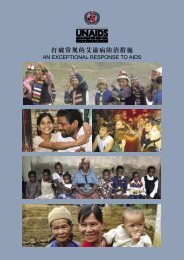What is HIV and AIDS?
What is HIV and AIDS?
What is HIV and AIDS?
Create successful ePaper yourself
Turn your PDF publications into a flip-book with our unique Google optimized e-Paper software.
Learning to know – cognitive skills<br />
• Dec<strong>is</strong>ion making/problem solving skills<br />
• Critical thinking skills<br />
Learning to be – personal skills<br />
• Skills for increasing internal locus of control<br />
• Skills for managing feelings<br />
• Skills for managing stress<br />
Learning to live together – communication <strong>and</strong> interpersonal<br />
skills<br />
• Interpersonal communication skills<br />
• Negotiation/refusal skills<br />
• Empathy<br />
• Cooperation <strong>and</strong> teamwork<br />
• Advocacy skills<br />
Morbidity rates The percentage of those who are ill during a particular span of<br />
time<br />
Mortality rates The percentage who die during a particular span of time<br />
Opportun<strong>is</strong>tic infections Infections caused by organ<strong>is</strong>ms that do not normally cause<br />
d<strong>is</strong>ease in people whose immune systems are intact. Some of<br />
the most common opportun<strong>is</strong>tic infections indicating that<br />
someone has <strong>AIDS</strong> are: PCP (pneumocystic carinii pneumonia),<br />
oesophageal c<strong>and</strong>idias<strong>is</strong>, toxoplasmos<strong>is</strong> etc.<br />
P<strong>and</strong>emic A d<strong>is</strong>ease prevalent throughout an entire country, continent or<br />
Post-exposure prophylax<strong>is</strong><br />
(PEP)<br />
the whole world<br />
Post-exposure prophylax<strong>is</strong> (PEP) <strong>is</strong> an emergency medical<br />
response that can be used to protect individuals exposed to<br />
<strong>HIV</strong>. PEP cons<strong>is</strong>ts of <strong>HIV</strong> antiretroviral medication,<br />
laboratory tests <strong>and</strong> counselling. Ideally PEP should be<br />
initiated within 2 to 24 hours (<strong>and</strong> no later than 48 to 72<br />
hours) of possible exposure to <strong>HIV</strong>, <strong>and</strong> must continue for<br />
approximately four weeks.<br />
Although PEP has not been conclusively proven to prevent<br />
the transm<strong>is</strong>sion of <strong>HIV</strong> infection, research studies suggest<br />
that if medication <strong>is</strong> initiated quickly after the possible<br />
exposure (ideally within 2 to 24 hours <strong>and</strong> no later than 48<br />
to 72 hours) it may be beneficial. The efficacy of PEP <strong>is</strong><br />
probably higher if treatment <strong>is</strong> started within the first few<br />
hours of exposure <strong>and</strong> <strong>is</strong> probably progressively reduced if<br />
started later. After 48 to 72 hours, the benefits are probably<br />
minimal (or non-ex<strong>is</strong>tent) <strong>and</strong> the r<strong>is</strong>k of intolerance <strong>and</strong><br />
side-effects associated with antiretroviral treatments will<br />
outweigh any potential preventive benefit.<br />
Prevalence A measure of the proportion of people in a population affected<br />
with a particular d<strong>is</strong>ease at a given time.<br />
NOTE: the terms prevalence <strong>and</strong> incidence should not be<br />
confused. Incidence only applies to the number of new cases,<br />
while the term prevalence applies to all cases old <strong>and</strong> new.<br />
Retrovirus A type of virus that <strong>is</strong> able to insert its genetic material into a<br />
host cell’s DNA. Retrovirus infections had not been found in<br />
human beings until recently. <strong>HIV</strong> <strong>is</strong> a retrovirus.<br />
30


